New Vrindavan Daily darsan @ June 29, 2014
Crossing beyond Lord Visnu’s illusory potency maya, distrusting women and frightened of their company, an intelligent man will choose to live very humbly in the land of Vrndavana.
[Source : Nectarean Glories of Sri Vrindavana-dhama by Srila Prabodhananda Sarasvati Thakura, Sataka-2, Text-70, Translation.]
Please click here for more photos
We Must Accept High Cost of Cow Protection, Says New Minister
We Must Accept High Cost of Cow Protection, Says New Minister
By: Madhava Smullen ISKCON News on May 15, 2014
We can have successful cow protection projects in ISKCON. But only if we’re willing to accept the high cost of violence-free milk, and of caring for cows and their handlers.
That’s the message that Shyamasundara Das, the recently appointed Global Minister for Cow Protection and Agriculture, is bringing to communities around the world.
In an age of convenience and cheap dairy products, he says, it all comes down to one thing: how important is cow protection to us?
Shyamasundara Das received his new title at the Annual General Meetings of ISKCON’s Governing Body Commission in Mayapur, West Bengal earlier this spring. He took on the service after former Global Minister Balabhadra Das resigned due to health issues.
Prior to that, Shyamasundara had overseen the Goshala (cow shelter) at Bhaktivedanta Manor near London in the UK since 1992, a position which he still holds. Under his leadership, the Manor’s herd has grown to fifty-seven cows and bulls, and is producing 40,000 liters of milk and logging about 3,000 ox hours a year.
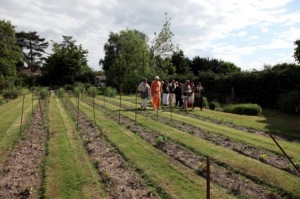 Devotees take a tour at the Bhaktivedanta Manor Farm Conference
Devotees take a tour at the Bhaktivedanta Manor Farm Conference
For the past six years, Shyamasundara has also served as European Minister for Cow Protection and Agriculture, and has toured ISKCON’s European farm communities, reminding them of the importance of cow protection and agriculture. His efforts have been set against a global decrease in energy and investment in such projects around ISKCON.
Through his tours, though, many European farms that were giving up cow protection have reactivated their projects and are now milking cows and working oxen. These include Radhadesh, Belgium; Simhachalam, Germany; Villa Vrindavana, Italy; Govindadvipa, Ireland; and New Mayapur, France.
Now, expanding his role as Minister for Cow Protection and Agriculture to a global one, Shyamasundara will spend his first year surveying and understanding ISKCON cow protection projects around the world.
He will then will take one month off a year from his service at the Bhaktivedanta Manor Goshala to travel around the world with his message.
He will naturally continue to vist Europe, holding the seventh annual ISKCON European Farm Conference in Simhachalam, Germany from September 16th to 18th, and looking to inspire the 30 or so leaders from all over Europe expected to attend.
But he also plans to visit a different continent every year, to encourage struggling communities to reactivate their cow protection and agricultural projects, as well as to work with ISKCON’s larger cow protection projects and assist them in coming to exemplary standards.
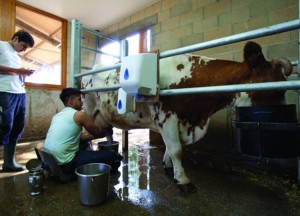 Devotees milk cows at New Gokula
Devotees milk cows at New Gokula
In Europe, Bhaktivedanta Manor’s New Gokula farm, and New Vraja Dhama in Hungary, which have similar-sized herds, are already extremely successful.
In the US, Shyamasundara also sees Gita Nagari in Pennsylvania and New Vrindaban in West Virginia as premier projects he wants to work with.
With 28 milking cows, 19 retired cows and oxen and 14 calves, Gita Nagari produces around 600 gallons of milk a week, has its own creamery and sells much of its yield to neighboring city temples. New Vrindaban, meanwhile, has 47 cows and oxen including six milking cows, and is attempting to use only protected cow milk in meals served at its temple.
Then, of course, there’s India. Shyamasundara plans to spend some time every year visiting the country, as ISKCON Founder Srila Prabhupada hoped goshalas there would set an example for others around the world.
While a lot of work is yet to be done to achieve this goal, Shyamasundara hopes that the goshalas in two of the most sacred places in India – Mayapur in West Bengal and Vrindavana in Uttar Pradesh – will develop to the point where they do set examples that ISKCON communities everywhere will follow. Mayapur in particular, with its plans to build a city for 50,000 people, will be a major focus.
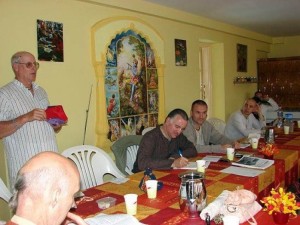 Shyamasundara Das (center, writing) at the first annual ISKCON farm conference in 2008 in Krishna-valley, Hungary.
Shyamasundara Das (center, writing) at the first annual ISKCON farm conference in 2008 in Krishna-valley, Hungary.
To all these projects, Shyamasundara is delivering his own “inconvenient truth”: if we want cow protection, we must accept the cost.
“Homegrown, Hare Krishna milk is six times the conventional price,” he says, explaining that this cost includes building and maintenance of a goshala, personal care to the cows, milking cows by hand rather than machine, and supporting people to care for the cows.
“Volunteers play a significant role in our cow protection projects, but the heart of them are people we maintain,” Shyamasundara says. “If you want stable cow protection, you have to have stable people. And stable people come if you meet their five needs: they need housing, work that’s satisfying for them, some social life, they need to be able to fulfill their children’s needs, and they need to be able to accumulate assets of some sort.”
Accepting all these costs will guarantee a successful cow protection program, Shyamasundara explains. And that’s important, even if it means reducing (but not stopping) milk use to be able to afford it. As Srila Prabhupada advised, “take as much milk as possible.”
Shyamasundara compares it to when gasoline prices skyrocket. People don’t stop driving, but they accept the situation, and adapt to it by cutting back on their gas consumption.
“It’s going to take a gradual negotiation and weaning process to get people to accept these higher economics,” he says. “It’s a slow process. But I think gradually, the message is being accepted.”
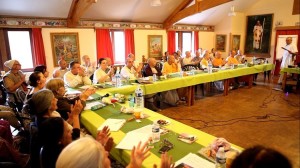 Devotees discuss veganism versus ahimsa milk at ISKCON’s European Leaders Meetings in 2013
Devotees discuss veganism versus ahimsa milk at ISKCON’s European Leaders Meetings in 2013
Just as important as accepting the price of protected cow milk is ISKCON’s responsibility to work oxen, according to Shyamasundara, even if it’s a major inconvenience for those of us used to the ease of the modern world.
“If we don’t make arrangements for oxen to work, we’ll be inadvertently making arrangements for tractors and other transport means to replace them,” he says. “So it’s going to require very bold, brave leadership.”
To keep local leaders focused and inspired to do something about cow protection, Shyamasundara plans to continue former Global Minister Balabhadra Dasa’s work in establishing regional representatives for cow protection and agriculture around the world, who will visit and encourage communities in their continents more regularly than he is able to.
Shyamasundara’s long term plan is to have all local leaders in ISKCON ask their communities for a plan on what to do about cow protection and agriculture, and how to do it. He would also like to see all major temples – especially in India – use their resources to work out an economic plan to ensure that every drop of milk they use comes from their own cows.
“I find it daunting, but very exciting to be part of the incredible dilemmas that Srila Prabhupada left us,” says Shyamasundara. “We have a mammoth task to establish cow protection and agriculture in a vastly declining society. Prabhupada was such a brave man and said such far reaching things. And it’s a challenge. But I like working with bulls, and I like cows. It suits my nature. So I’m happy to play this role, and I’m excited to be part of this element of his mission.”
New Vrindaban’s 8th Annual 24 Hour Kirtan A Transcendental Success
New Vrindaban’s 8th Annual 24 Hour Kirtan
By Lilasuka dasi
It was only the third hour into the 8th annual summer 24 hour kirtan in N.V., on Saturday June 21, 2014, when the kid kirtaniyers jumped right in. Well “trained up” by their parents, each of the mostly third generation children took their turn expertly leading their few minutes of kirtan, and the crowd eagerly showed their appreciation and amazement with exuberant cheers.
Just a couple of hours after that, some of New Vrindaban’s own finest guitar and harmonium players lead their sweet kirtans, with soft flute accompaniment.
The participants had a lot to say about the different moods and tunes of the day and night:
A visitor remarked: “The energy from the different kirtan leaders really drives each special kirtan and makes it all very inspiring.”
With a faraway look in her eye, one young lady said, “Bhakti Caru Swami’s purity shines through in his slow and melodious kirtan, and uplifts me.”
One New Vrindaban resident surprised herself: “Although I absolutely love the 24 hour kirtans, I usually can’t stay up very late, but, for some reason, this time I was able to stay a lot longer. And then, even when I got home, I just turned the radio to 88.0, the local NV channel, and basically listened to the kirtan all night.”
Manu, one of the main organizers of the 24 hour kirtan schedule, commented, “24 hour kirtan – very engaging and inspiring. I’ve been doing administrative, organizational work most of the time this weekend. But at 2 a.m. Saturday morning, I was able to sit and just be in the kirtan. Just at the time when you think you have nothing left to give, the holy name engages you. It’s not about the musicality or the crowd, but the power of the holy name.”
Lakshman prabhu, a cook at the restaurant exclaimed: “The first meal on Saturday, we cooked for 250 but there were more than 500 people who came – quite a bit more than we thought. That’s a good challenge to face!”
One visitor, who sat mostly in one spot for much of the 24 hours, often chanting with closed eyes, and who had a hard time putting his intense kirtan experience into words, did finally comment, “What’s so special about this kirtan is the atmosphere of this big, beautiful Radha Vrindaban Chandra temple.”
Ganga das from Florida agreed with that and added, “Any association of devotees is amazing, and this is one of the best occasions for association available. It’s like charging your batteries, especially when you live outside a temple like I do. This association is so important. And everyone chanting together creates a very special energy.”
Gita dasi was there with her husband, Dhruva from Alachua. Gita’s favorite part of the kirtan was letting her baby dance in the kirtan. Also, her favorite singers were singing from midnite to 2 a.m., and although she was tired and couldn’t imagine staying up another minute, the enchanting, soft singing of the early morning kirtaniyers filled her soul with spiritual energy.
A couple from the city of Cincinnati, Ohio offered this comment: “When we come here from our small home town temple, I love taking this wonderful energy home with me, and it stays with me for a long time.”
Srila Prabhupada Repeats His “Simple Living, High Thinking” Message for a New Vrindaban Resident – August, 1974.
Srila Prabhupada Repeats His “Simple Living, High Thinking” Message for a New Vrindaban Resident – August 1974.
From a series of letters written by Srila Prabhupada outlining his vision for New Vrindaban.
Thanks to Vanipedia for the source material.
———————————————————————-
New Vrindaban
My dear Madhukara das,
Please accept my blessings. I am in due receipt of your letter dated July 25th 1974 and thank you very much for your nice sentiments. Just as you were pleased that I was able to visit New Vrindaban, so did I also enjoy my visit to New Vrindaban. You are producing nice vegetables from the earth and ample supply of milk from the cows so what more do you want? Just chant Hare Krishna and everything will be alright.
Regarding the two twenty dollar checks that you had sent previously. It has not been recorded because of the change of secretaries. I suggest that you contact your bank whether or not the checks have been deposited and you can inform me.
I hope this meets you in good health.
Your ever well wisher,
A.C. Bhaktivedanta Swami
ACBS/bs
A Special Exit from the World in New Vrindaban
Last Flight
By Lilasuka dasi
A little brownish baby sparrow slowly hopped into the middle of the lobby of the Radha Vrindaban Candra temple, and just stood there, looking a bit lost.
It turns out she wasn’t lost at all, as Lord Krsna was apparently very much guiding her from within.
As it happened, Dasi, who was passing through the lobby during her busy day of serving the Lord, stopped short. She couldn’t help but notice the little bird. Dasi thought, “I wonder if this tiny sparrow is a friendly animal, or maybe she just needs help.”
She slowly kneeled down a few steps away, so as not to startle the little one, and gently held out her scarf for the bird to hop on.
Our feathered friend did just that! The little sparrow walked right up onto her scarf as if she’d been waiting for the invitation!
Then the baby appeared to just fall asleep on the scarf. After a few minutes she woke up again, and became alert, but didn’t try to fly away.
By this time, Dasi had taken the little sparrow to her office and set her in a basket lined with flower petals that had been offered to Srila Prabhupada that morning, next to her laptop, where she played some soft bhajans of her guru maharaj soothingly chanting Hare Krsna.
Fearing the worst, she sprinkled the resting bird with the Lord’s own caranamrita (bathing water).
After only a few short minutes, the sparrow quietly left her body, listening to the chanting of the Lord’s Holy Name!
Such is the mercy of the Lord, which often comes at unexpected times and in wonderful ways.
Visitor to New Vrindaban’s Palace of Gold takes inspiration.
Have you read the Science of Self Realization?
By Krishna Bhava dasi
Sometimes with his mother and sometimes with his son, Herbie has been visiting NV for a decade, “Under the radar” as he likes to say. Originally from Kent, Ohio, he moved to West Alexander, WV.
Ten summers ago he decided to take a camping vacation near the Palace of Gold. One day while driving to his campsite, he discovered the Palace. He had always been interested in different religions and was very attracted.
He went into the Palace gift shop, Krpamaya das shared with Him some passages from the Bhagavad Gita and he bought a Science of Self Realization. After reading the Science of Self Realization he became inspired. He works for a large corporation and teaches customer relations to thousands of people. While teaching them customer relations he now tries to incorporate principles from Srila Prabhupada’s Science of Self Realization. In his work place he has inspired over 40 workers to download the Science of Self Realization and they have discussions on it.
Last summer I was very enlivened when he shared his story with me and the last thing he said to me was “Have you read the Science of Self Realization?”
The author of this article, Krishna Bhava das,i has lived in New Vrindaban for over 30 years, having done lots of different services, while raising two children as well. She now runs the Palace Gift Shop at Prabhupada’s Palace of Gold.
 Krishna Bhava with her daughter, Krishna Priya.
Krishna Bhava with her daughter, Krishna Priya.
New Vrindaban’s Transcendental Throwback Thursday – 06/26/14
New Vrindaban’s Transcendental Throwback Thursday – 06/26/14.
Each week we highlight an earlier era of ISKCON New Vrindaban.
This week’s challenge: Can you identify the cart driver and two horses in this photo?
Extra credit: What year and where do you think it was taken?
What to do: Post your guesses on the “who, what, when, where & why” in the comment section at the New Vrindaban Facebook Page.
Technical stuff: We share a photo Thursday and confirm known details Sunday. Let’s keep it light and have a bit of fun!
Special request: If you have a photo showing New Vrindaban devotees in action, share it with us and we’ll use it in a future posting.
New Vrindaban’s Palace Rose Garden Decides to Switch to Sustainability
Prabhupada’s Palace Rose Garden Making the Switch to Sustainability
by Lilasuka dasi
Prabhupada’s Palace of Gold at New Vrindaban didn’t always have the stunning, bursting-with-color rose garden that every visitor now gets to enjoy. Twenty-six years ago, in 1988, Betty Hickey, a horticulturalist, and a good neighbor of New Vrindaban, from a nearby farm, and someone who appreciated the devotees, had the idea to establish the rose garden for the Palace. So she created and even maintained it herself, with the devotees’ blessings and help.
Even before internet days, she extensively researched the care of roses, and soon became a skilled rosarian.
Since Betty retired in 2012, a seasoned gardener Vaisnavi, Gopalasyapriya dasi is taking the responsibility for the garden, with some great helpers. Mukunda dasi cuts down and mulches the garden in the fall; Purnima dasi, Gopa’s main helper, works at the garden all summer; Srimati helps occasionally, along with Krsna Lila, Mukunda’s daughter. Gopa herself has done most of the spraying, fertilizing, green house planting and organizing. Tripad vibhuti das has been managing and overseeing the whole Palace of Gold project for 20 years now .
Switch to another scene for a minute. About the same time that Betty was establishing the Palace’s magnificent rose garden, back in the late ‘80’s, a man named Paul Zimmerman, in another part of the country, wanted to do something new in his life, so he got into gardening, specifically with roses. Soon, Paul started a “rose care” company in California where he mostly took care of other people’s gardens.
Thus began Paul’s journey of sustainable rose care, and his current connection with New Vrindaban and Prabhupada’s Palace Rose Garden.
Paul claims: “The common perception amongst gardeners is that roses are fussy, and need lots of chemicals in order to thrive. Not true! We focused on a more natural, organic nursery for our roses. We knew that roses did not have to have all sorts of chemicals to be healthy and flourish.”
Paul feels that sustainability is now here to stay, and would be great for the Palace roses.
“Most of the harsh rose chemicals are now outlawed anyhow!”
Paul continues, “A lot of public rose gardens are getting the command from visitors that if they come to the garden, and they see that the rosarians are spraying with masks and gloves on, they just won’t visit.”
Paul is a consultant. He had great success in transforming the well-known Biltmore Gardens in Asheville, NC to organic, so we knew that he had credibility. (Read more about Paul’s work at: http://paulzimmermanroses.com/) Gopa is the liason for the Palace with Paul Zimmerman, who first came on April 1, 2014 and then for a second visit to see the progress and help them along on June 11, 2014.
Gopa expressed it this way, “We are switching to a more sustainable Palace rose garden for several reasons. We are hoping that the younger generation, who are very environmental-conscious, and largely anti-chemicals, will be attracted to carrying on the work after we older women can no longer do it. The rose garden is very much appreciated and most people understand how difficult it is to maintain. A chemically sprayed rose garden is also becoming more objectionable to the residents of the community.”
“Madhava Ghosh, who is involved with New Vrindaban’s ECOV board, helped to connect Paul with us. Paul found us through our past connection with the All American Rose Selection, who had provided us many awards in the ‘80’s, but is now defunct. ECOV is instrumental in financing this sustainable project,” Gopa continues.
Gopa feels it will be more work, “but it’s definitely worth a try. It’s becoming more difficult to even spray with chemicals because I’ve had to start wearing a mask. But this year, we won’t put down any herbicide. Instead, Paul recommended that we start with a thick, two inch layer of compost and heavy mulch on all the beds, and spraying with vinegar, which is much more natural. We will also need to simply remove some of the weaker brands of roses and replace them with more naturally bug-resistant rose strands.”
The Palace currently has about 800 plants total, of 150 different species.
Paul explained to Gopa, “The idea is to not necessarily be out there spraying whether there are diseases there or not, BUT to build the rose’s immune system so it can fight disease, just like humans.”
Paul is excited, “This Palace garden has “great bones”!!! It’s a good garden that can also be sustainable. We don’t need the chemicals. The more I learn about your community, the more I think that sustainability resonates with the people. I understand that your community is getting better at trying to waste less, and is working towards recycling. And your high spiritual philosophy includes taking care of the earth planet. You will certainly be able to use the Palace Rose Garden as a phenomenal educational opportunity.”
How long will it take to get the Palace roses sustainable?
“Well,” Paul explains, “At the Palace, you can’t do this “cold turkey” because you don’t have the luxury of being able to close down! Your guests have expectations that they want to see the rose garden whenever they come here. So, I say this would be a two to three year process. The first year: build your foundation. Then, the second and third years: change some elements in the garden, wean the roses and add some new plants that take a year or two to grow.”
Paul revealed another very exciting aspect of this whole sustainable rose project.
“Just think,” Paul declared, “When the garden goes sustainable, then all the rose petals will be organic and can be used for so many products, like rose petal jelly, rosehip tea, rose oil, rose water, and more. You can begin to make your own products and sell them. This rose garden can produce some income and advertisement for the community.”
Gopa is excited about the possibilities, “We want the Palace Rose Garden to become a more integral part of what we do here in the New Vrindavan community.”
The proof is in the seeing and smelling! Everyone is invited to come and visit Srila Prabhupada’s Palace of Gold Rose Garden, open all spring and summer until the last West Virginia frost.
Srila Prabhupada Describes His Bhagavat Dharma Discourses Held in New Vrindaban – Sept 1972
Srila Prabhupada Describes His Bhagavat Dharma Discourses Held in New Vrindaban – Sept 1972.
From a series of letters written by Srila Prabhupada outlining his vision for New Vrindaban.
Thanks to Vanipedia for the source material.
——————————————————————
Denver, Colorado
My dear Radha Damodara,
Please accept my blessings. I thank you very much for your letter dated August 25, 1972, and I appreciate very much for your kind sentiments. Yes, the Bhagavata Dharma discourses here in New Vrindaban are going on very nicely and daily several hundred devotees and guests are coming to hear, and it is truly a wonderful time.
I am glad to hear the nice report about St. Louis temple, and also that you are training yourself up nicely to be a serious preacher of this Krishna Consciousness movement. That much is wanted, sincere men who will become very strong for preaching work throughout the world, on behalf of Krishna. Now you apply yourself to this task very seriously and become learned in all the aspects of our Krishna Consciousness philosophy and take this opportunity in this lifetime to go back to Home, back to Godhead. That is my request.
I have not yet seen the Devotee Sketch-book #2, but I shall see it when I again return to Los Angeles.
Hoping this will meet you in good health.
Your ever well-wisher,
A.C. Bhaktivedanta Swami
ACBS:sda
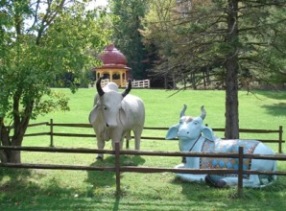
Welcome to Brijabasi Spirit
Thank you for taking the time to visit the New Vrindaban community blog. Think of visiting our blog as making a virtual pilgrimage.
Hare Krishna Hare KrishnaKrishna Krishna Hare Hare
Hare Rama Hare Rama
Rama Rama Hare Hare
"May cows stay in front of me; may cows stay behind me; may cows stay on both sides of me. May I always reside in the midst of cows."
Hari Bhakti-vilas 16.252



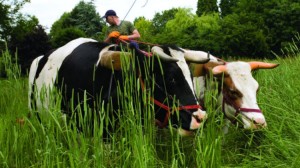
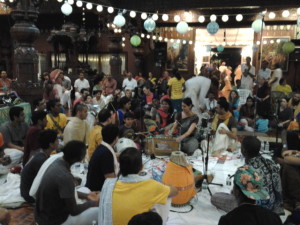
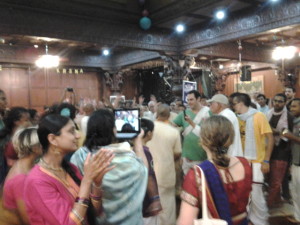
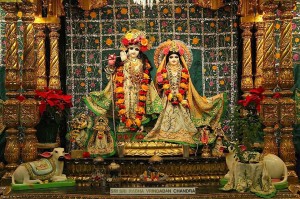
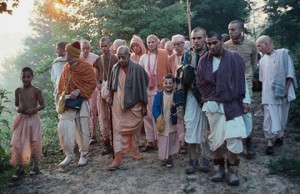









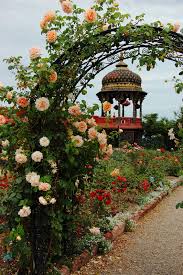
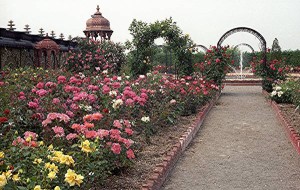





Recent Comments